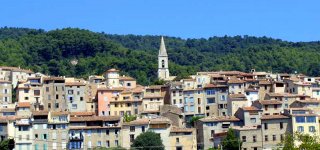The village of Callas
Jewel inside Var, located halfway between the fascinating Gorges du Verdon and the Mediterranean coast, the hilltop village of Callas has a sublime and contrasting natural setting.
Between sea and mountain, near Draguignan, the picturesque site Callas stands on a unique landscape designed by the deep green of pine forests, the red gorges of Pennafort and silver olive trees.
Perched on a hillside between 400 and 800 m, the village of Callas offers stunning views of the Esterel Mountains and onto the Mediterranean. The houses all in height, topped with dry-figs attics, part of the picturesque and charming village with its steep alleys, its succession of staircases and vaulted passageways.
Full of history, Callas retains an architectural heritage inherited from various periods, from the Middle Ages to the 19th century. A Ligurian oppidum certifying that the site was already occupied during antiquity. From the 11th to the 16th century, the village is then up to the Provencal noble family of Pontevès. The second part of the 16th century is marked by significant Provence peasant revolts. A peasant from even Callas. The Viscount and his descendants are killed in the revolt. The Lordship of Callas will be sold several times during the 17th century. In the early 18th century, Callas is offered to Louis XV and became a royal town in 1720.
The heart of the village of Callas is rich with a beautiful architectural heritage of old doors, fountains, bell tower of the town hall dating from the first 19th century, and the remains of the castle of Pontevès. The religious heritage is represented by the Church of Our Lady of the Assumption Roman style, which contains beautiful murals of the 19th century, as well as three chapels which two are located outside of the village.
St. Auxile chapel is a Romanesque building built between the 7th and the 12th century on a rocky promontory at 1500 meters from the village. Located at the site of an ancient Gallo-Roman site, the chapel saw its architecture be changed four times during the 5 centuries. It celebrates a Frejus bishop of the fifth century successor of Saint-Leonce and assassinated in 480 by order of the king of the Visigoths evaric. Restored at the end of the 20th century, the chapel is freely visit all year round, and is subject to occasional tours.
Much more recently, the Notre-Dame-de-Pennafort was built in the mid-19th century on the site of an old Saracen tower. Its Greek Revival architectural style contrasts with the remains of the medieval tower and the surrounding wilderness.
The Trinity Chapel is finally known as the mausoleum of Callas. Material Safety and explanatory panels to make the site visit freely.
Cultural and Natural Heritage, the olive tree is the center of callassien territory. The olive cultivation is an ancestral local specialty. At the end of the 19th century, the territory of Callas has more than 55 thousand olive trees, whose crops feed the plants Draguignan and many local mills. The old hydraulic mill communal Callas in activity until 1956 frost, can be visited today. The trail leads from the collection in the olive grove to the oil manufacturing method old.
olive producer for several generations, the Mill is a must Bérenguier Callas: his oils were awarded to national agricultural shows repeatedly. Specialized in variety of olives "ribier" Callas Mill also offers handicrafts such as tapenade, cosmetics and gift sets.
